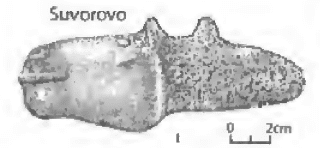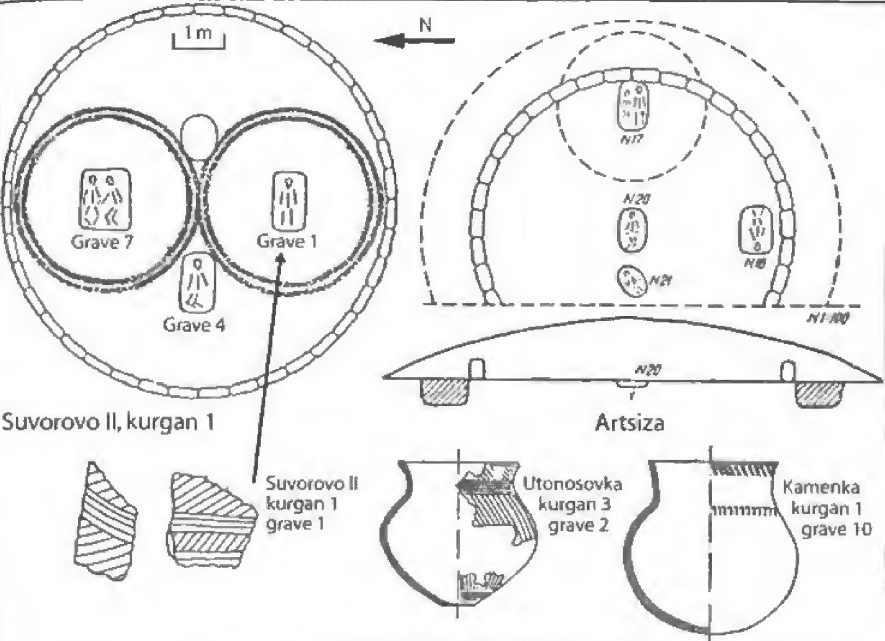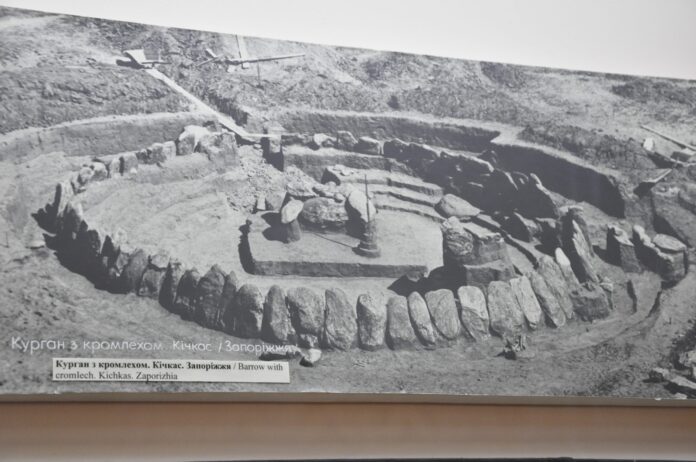According to the Wiltshire Museum, the man buried close to Stonehenge in the Bush Barrow, was given Britain’s richest Bronze Age burial. The Bush Barrow Chieftain died in about 1950 B.C. and was buried under a barrow on top of a ridge looking down over Stonehenge. He was buried with the objects that symbolized his power and authority – an axe, ceremonial mace, gold sheet lozenge, and two bronze daggers. His axe and daggers resemble those carved on the stones at Stonehenge.” Below is a short video describing the find.
American Professor of Anthropology David W. Anthony in his recent book “The Horse, the Wheel and Language” (Wiki) described a burial of Suvorovo culture that dates to the 4th millennium B.C., thus predating the Bush Barrow by two thousand years: “The Suvorovo kurgan was 13 m in diameter and covered four Eneolithic graves. Stones a meter tall formed a cromlech around the base of the mound. Within the cromlech, two smaller stone circles were built on a north-south axis, each surrounding a central grave. Grave 7 was the double grave of an adult male and female buried supine with raised legs, heads to the east. The floor of the grave was covered with red ochre, white chalk, and black fragments of charcoal. A magnificent polished stone mace shaped like the head of a horse lay on the pelvis of the male. Belts of shell disk beads draped the female’s hips. The grave also contained two copper awls made of Balkan copper, three lamellar flint blades, and a flint end scraper. Grave 1, in the other stone circle, contained an adult male in an extended position and two sherds of a shell-tempered pot.”

Who were those people and where did they come from? Dr. Anthony answers that question: “The first Suvorovo herders who appeared on the northern edge of the Danube delta about 4200-4100 BCE might have brought some of their cattle south from the Dnieper steppes during a period of particularly cold winters.”
Some of them did not stop there and continued their way south. “Pre-Anatolian languages probably were introduced to the lower Danube valley and perhaps to the Balkans about 4200-4000 BCE by the Suvorovo migrants. We do not know when their descendants moved into Anatolia. Perhaps pre-Anatolian speakers founded Troy I in northwestern Anatolia around 3000 BCE.”
One can learn more insights about the topic in the “Cradle of Civilization” hardcover book.
< PREVIOUS ARTICLE that seemingly gets yet another confirmation taking into account the information below about the Syvorovo Culture burials. By the way, does the pot sherd ornamentaion resemble the one in the video above about the Bush Barrow?

According to D. Anthony, the Suvorovo cemetery at Giurgiulesti, near the mouth of the Prut, contained five graves grouped around a hearth full of burned animal bones. Can we recognize the future Scythian burial feasts tradition in this instance? Can we see the beginning of the Scythian era in those Suvorovo graves of the 4th millennium already? NEXT POST >










